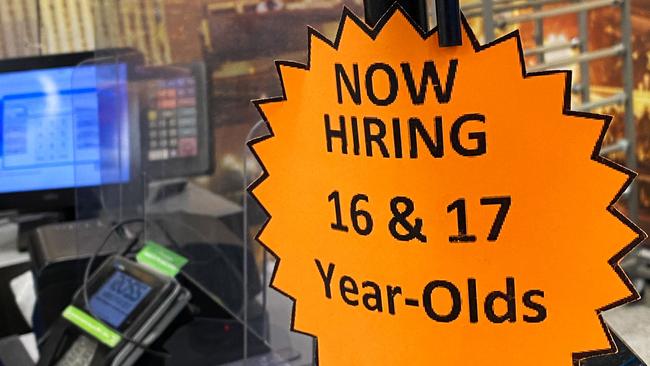
After a brief dip last week as Federal Reserve chair Jerome Powell said a March rate cut was unlikely, the US stockmarket hit record highs on Friday only because some of the Magnificent Seven tech stocks surged on earnings optimism. The rally had little to do with the US jobs data, which were stronger than expected.
In fact, the data were an added valuation headwind for stocks as bond yields took off on news that January jobs growth was much stronger than expected with big upward revisions, a lower than expected jobless rate and higher than expected average hourly earnings growth.
The US jobs growth of 353,000 in January compared to a median forecast of 185,000 and upward revisions totalled 185,000. The unemployment rate remained at a very low 3.7 per cent versus 3.8 per cent expected, and wages growth accelerated to 4.5 per cent versus 4.1 per cent expected.
Australia’s S&P/ASX 200 share index fell 1 per cent on Monday after hitting a record high on Friday. The Australian dollar hit a two-month low of US64.86c as market pricing for Australian interest rate cuts increased after lower than expected inflation data last week and pricing for US rate cuts decreased after the US non-farm payrolls data released Friday.
Domestic markets will hinge on the extent to which the Reserve Bank’s new monetary policy board tweaks its hawkish interest rate guidance after lower than expected inflation data.
The RBA’s two-day meeting concludes at 2.30pm with a decision statement and quarterly statement on monetary policy – including updated economic forecasts – to be followed at 3.30pm by an inaugural post-meeting press conference from governor Michelle Bullock.
Stronger than expected December quarter US economic growth data a week earlier were of the “Goldilocks” variety, as they were accompanied by lower than expected inflation indicators.
But the jobs data may be too much of a good thing in terms of economic growth and the potential for renewed inflationary pressures after a 525 basis point lift in the Fed funds rate since March 2022.
The US 10-year bond yield jumped 14 basis points to 4.02 per cent and hit a four-day high of 4.09 in Asia Pacific trading after Powell continued to push on market expectations of rate cuts.
In an interview recorded with CBS’s 60 Minutes that aired on Monday Australian time, the Fed chair said it was unlikely that the Federal Open Market Committee would “reach that level of confidence” on inflation to be able to cut rates in March.
The “danger of moving too soon is that the job’s not quite done, and that the really good readings we’ve had for the last six months somehow turn out not to be a true indicator of where inflation’s heading,” Powell said.
“We don’t think that’s the case, but the prudent thing to do is to just give it some time and see that the data continue to confirm that inflation is moving down to 2 per cent in a sustainable way.”
60 Minutes said Powell suggested the first cut could happen around the middle of the year, but the transcript of the interview – including some not aired on the program – didn’t show that.
The interviewer reported that Powell “suggested to us the likely time for the first interest rate cut would be the middle of the year, a few months before the election”. The interviewer also told the audience that cuts “would likely be a quarter, maybe half, of a percentage point at a time.”
In the wake of that interview, Goldman Sachs economists warned that Powell’s 60 Minutes interview “raises the risk” that the Fed will start cutting rates in the middle of the year rather than May.
“We are not changing our forecast for the first cut to come in May at this time because we are unsure what exactly Powell said outside of the interview and because our inflation forecast is lower than the FOMC’s, but we now see a greater chance of a ‘later but steeper’ path in which the first cut would come later than May,” said Goldman Sachs chief economist Jan Hatzius.
In his 60 Minutes interview, the Fed chief said he didn’t expect policymakers to “dramatically” change their 2024 interest-rate forecasts, which in December showed they expected the benchmark lending rate to fall from a target range of 5.25-5.50 per cent to 4.5-4.75 per cent by year-end.
“All but a couple of our participants do believe it will be appropriate for us to begin to dial back the restrictive stance by cutting rates this year,” Powell said. “And so, it is certainly the base case that … we will do that. We’re just trying to pick the right time, given the overall context.”
T. Rowe Price said the RBA was likely to follow the Fed’s lead in pushing back on imminent rate cuts. “We saw a CPI print that failed to meet expectations and was also below the RBA’s expected path, which should remove the risk of one final hike,” said Scott Solomon, co-portfolio manager of the T. Rowe Price Dynamic Global Bond Strategy.
“However, we expect the RBA to push back on the idea that the rate cutting cycle is just around the corner. We believe the Fed has created a nice template for the RBA to follow.”
While he thinks the RBA will be “forced to cut” sometime this year, Solomon expects it will be after the Fed begins its cutting cycle, which now appears unlikely to start until May at the earliest.







For markets betting on interest rate cuts, the strong US jobs data wasn’t exactly great news.